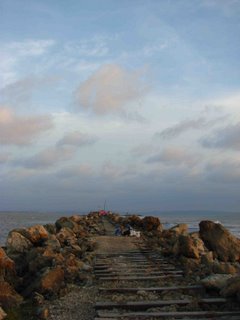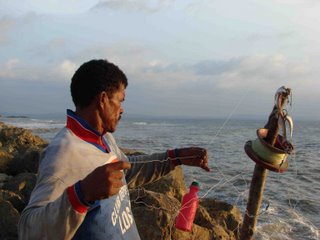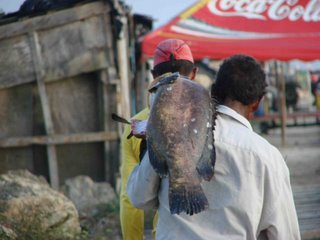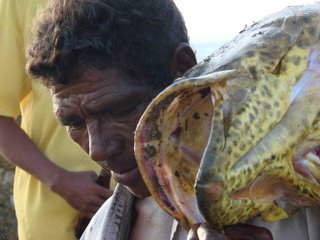Bocas de Ceniza
Yesterday we had a beautiful day! Gustavo invited me, Amy, and Christine to his house for lunch (see my flickr account for photos of us wearing hats from around the world) and then we had drinks at a restaurant that sits above the waters of the Magdalena River. It was so beautiful and tranquil, watching the birds and enjoying a break from the overwhelming heat of the city.

From the restaurant, we rode a rickety little train powered by a motorboat engine out to Bocas de Ceniza, the area where the Magdalena River meets the Caribbean Sea. Rio Magdalena is Colombia's biggest and most important river and this area is called The Port of Gold because of all the commerce it brings into the country. Bocas de Ceniza was built in the 1930s to make navigation easier and is basically a long strip of land that juts out 10 kilometers to divide the fresh and salty water. It's called Bocas de Ceniza (Mouths of Ashes) because when the waters mix they have a gray, ashy look.

I was expecting a beautiful view, but I wasn't expecting to also find a community of poor fishermen living and working on this narrow, rocky jetty, so far from the city and its amenities. Beautiful, old, wooden boats line the shore and the homes are tiny and weathered by the waves and the sun. Some of the men fish with nets, but many use a complicated (yet brilliant) fishing system involving a kite, a bottle of water, and four baited hooks, which this man demonstrated for me and Amy.

After being used to construct the jetty, the train tracks that connect Barranquilla to Bocas de Ceniza had been closed for almost 30 years. In 2003, Colombia's president ordered them open again in order to boost the economy of the area. As a tourist trap, Bocas de Ceniza is unlike anything I've ever experienced. Multiple small trains (trencitas) share the single track, so at three times during our 10 kilometer trip we had to step off and wait as the conductors lifted the train off the track to allow another to pass. Close to the end of the jetty, the tracks had been so jostled by the water and rocks that the wooden planks lie scattered at severe angles. Along the way, we passed several small clusters of houses built between the tracks and the sea, where residents sell snacks, water, and beer from coolers. We bought four waters for 1200 pesos, or just over 50 cents total. In addition to tourists, the train tracks also service the fisherman by allowing them to transport their fish into town and collect fresh water. One fisherman and his giant, two-foot-long catch rode the train back with us. We learned that he would make approximately 70,000 Colombian pesos selling it, probably to a local restaurant at the end of the tracks. This should be enough money to take care of his needs for a few weeks.


From the restaurant, we rode a rickety little train powered by a motorboat engine out to Bocas de Ceniza, the area where the Magdalena River meets the Caribbean Sea. Rio Magdalena is Colombia's biggest and most important river and this area is called The Port of Gold because of all the commerce it brings into the country. Bocas de Ceniza was built in the 1930s to make navigation easier and is basically a long strip of land that juts out 10 kilometers to divide the fresh and salty water. It's called Bocas de Ceniza (Mouths of Ashes) because when the waters mix they have a gray, ashy look.

I was expecting a beautiful view, but I wasn't expecting to also find a community of poor fishermen living and working on this narrow, rocky jetty, so far from the city and its amenities. Beautiful, old, wooden boats line the shore and the homes are tiny and weathered by the waves and the sun. Some of the men fish with nets, but many use a complicated (yet brilliant) fishing system involving a kite, a bottle of water, and four baited hooks, which this man demonstrated for me and Amy.

After being used to construct the jetty, the train tracks that connect Barranquilla to Bocas de Ceniza had been closed for almost 30 years. In 2003, Colombia's president ordered them open again in order to boost the economy of the area. As a tourist trap, Bocas de Ceniza is unlike anything I've ever experienced. Multiple small trains (trencitas) share the single track, so at three times during our 10 kilometer trip we had to step off and wait as the conductors lifted the train off the track to allow another to pass. Close to the end of the jetty, the tracks had been so jostled by the water and rocks that the wooden planks lie scattered at severe angles. Along the way, we passed several small clusters of houses built between the tracks and the sea, where residents sell snacks, water, and beer from coolers. We bought four waters for 1200 pesos, or just over 50 cents total. In addition to tourists, the train tracks also service the fisherman by allowing them to transport their fish into town and collect fresh water. One fisherman and his giant, two-foot-long catch rode the train back with us. We learned that he would make approximately 70,000 Colombian pesos selling it, probably to a local restaurant at the end of the tracks. This should be enough money to take care of his needs for a few weeks.


0 Comments:
Post a Comment
<< Home